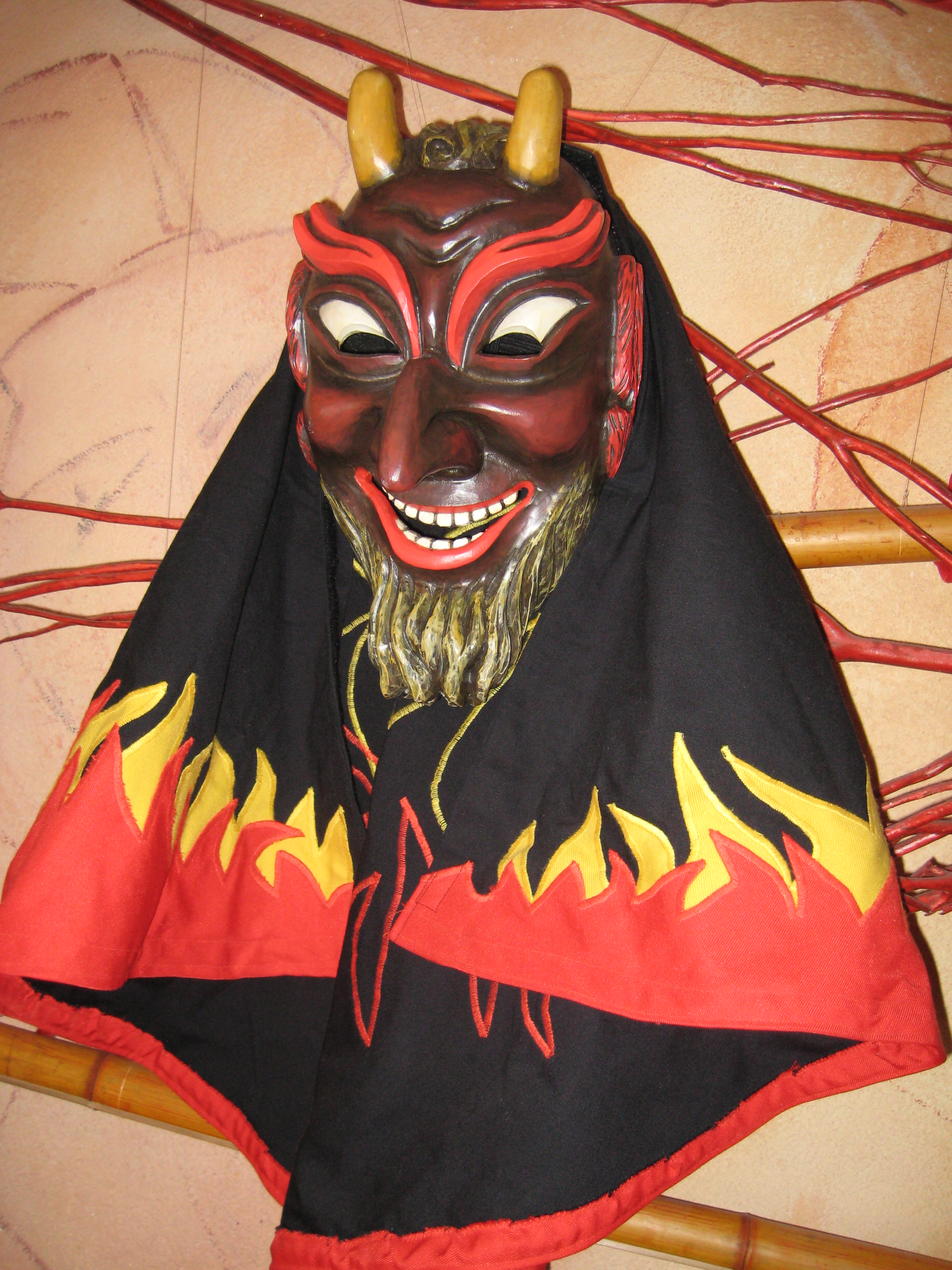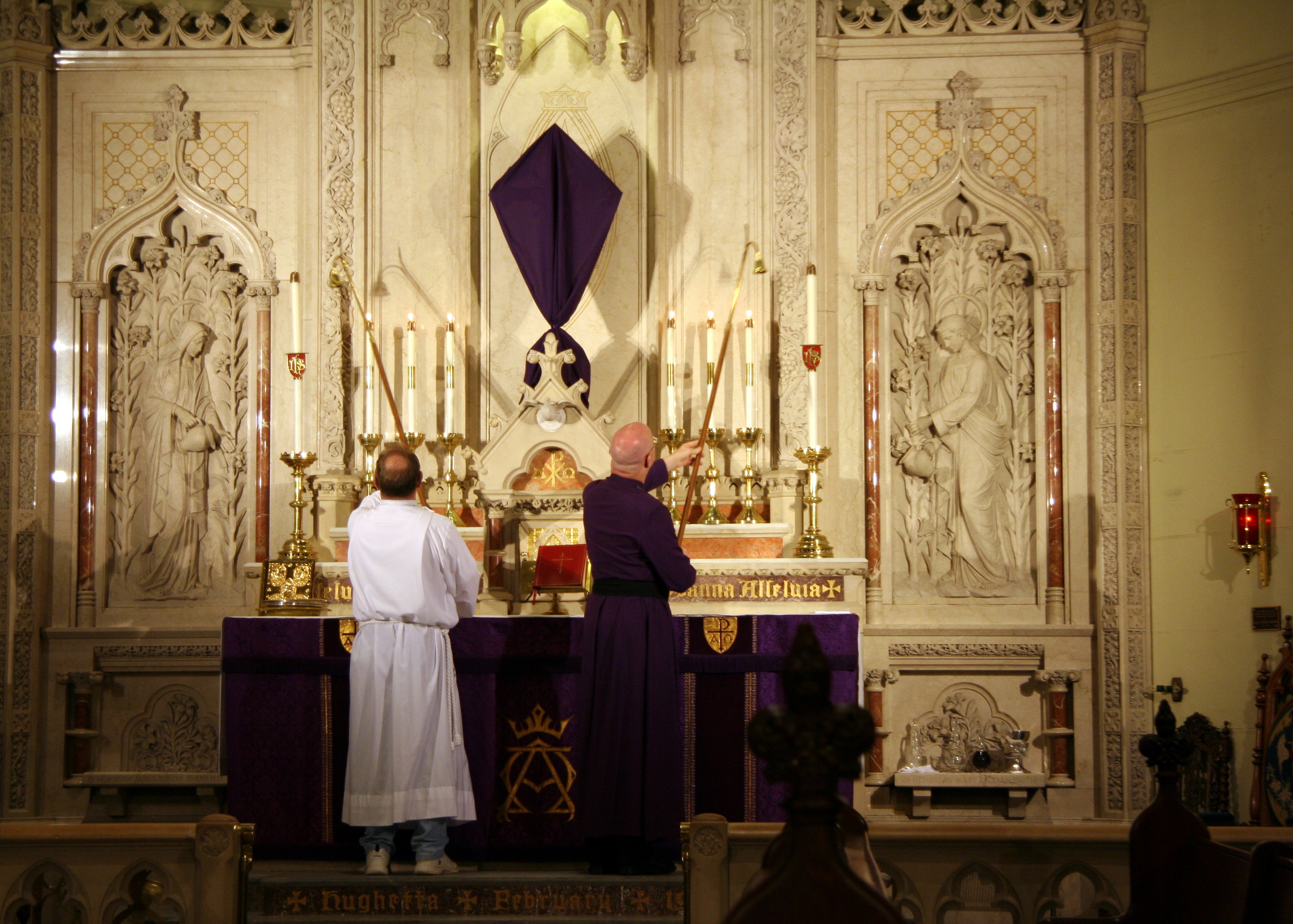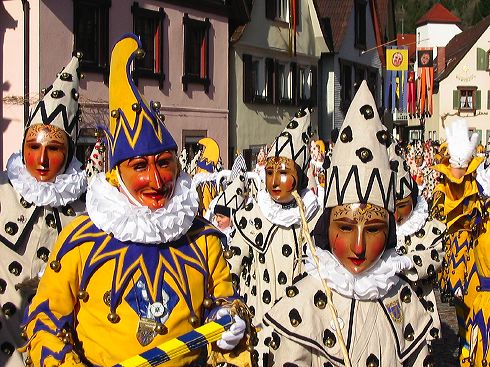|
Der Überlinger Hänsele
The Überlinger Hänsele is a famous Swabian-Alemannic-Fastnacht, carnival figure of the city of Überlingen am Bodensee, Germany. The Hänsele is the main figure of the carnival in Überlingen. Only male citizens of Überlingen are allowed to appear with this carnival suit on. The first time the Hänsele appears during carnival is the Saturday evening before Ash Wednesday for the big "Hänsele Juck" (procession of the Hänsle through the old city of Überlingen). More than 1500 of these Hänsele entertain the audience along the street. Appearance The character Hänsele appears on the Saturday and Sunday before Ash Wednesday. It also appears in July in connection with the Überlinger Schwerttanzkompanie (Sword dance company of Überlingen) at the second Schwedenprozession (a procession to commemorate the successful defense of the Swedish Empire, Swedish siege in the Thirty years War) on the second Sunday in July. During the sword dance only one person at a time plays Hänsele, a ... [...More Info...] [...Related Items...] OR: [Wikipedia] [Google] [Baidu] |
Swabian-Alemannic-Fastnacht
The Swabian-Alemannic Fastnacht, Fasnacht (in Switzerland) or Fasnat/Faschnat (in Vorarlberg) is the pre-Lenten carnival of Alemannic folklore in Switzerland, southern Germany, Alsace and Vorarlberg. Etymology Popular etymology often links ''Fastnacht'' (in Mainz also ''Fassenacht'', in Switzerland ''Fasnacht'', in Swabia ''Fasnet'', ''Fasent'') with ''fasten'' ("to fast") – allegedly from celebrations on the eve preceding fasting. In the beginning of the 20th century it was a common assumption that the tradition had its roots in pre-Christian ritual. Comparison of dialect variants, however, yields an Old High German ''*fasanaht'', with an element ''fasa-'' of unclear meaning. A likely derivation looked to Proto-Indo-European ' "purify" (cognate to '' pava-mana''), or alternatively to Middle High German ''vaselen'' "prosper, bud", and interpreted the festival as a fertility rite. Historians around Werner Mezger refuted those theories, and showed that the name derives from ... [...More Info...] [...Related Items...] OR: [Wikipedia] [Google] [Baidu] |
Überlingen
Überlingen (; ) is a German city on the northern shore of Lake Constance (Bodensee) in Baden-Württemberg near the German-Swiss border, border with Switzerland. After the city of Friedrichshafen, it is the second-largest city in the Bodenseekreis (district), and a central point for the outlying communities. Since 1 January 1993, Überlingen has been categorized as a large district city (''Große Kreisstadt''). History The history of Überlingen dates back to Switzerland in the Roman era, Roman times, but a variety of settlements antedated Roman occupation. Stone Age settlements, discovered along the shoreline of Lake Constance, document that the lake supported several dozen thriving communities of 50–100 individuals. These settlements fall under the category of the Hallstatt culture, and their habits, dress, and diet have been illuminated through the excavation of archaeological sites, such as a major site in Hallstatt, Austria, excavated in the mid- to late 19th century.Al ... [...More Info...] [...Related Items...] OR: [Wikipedia] [Google] [Baidu] |
Carnival
Carnival (known as Shrovetide in certain localities) is a festive season that occurs at the close of the Christian pre-Lenten period, consisting of Quinquagesima or Shrove Sunday, Shrove Monday, and Shrove Tuesday or Mardi Gras. Carnival typically involves public party, celebrations, including events such as parades, public street party, street parties and other entertainments, combining some elements of a circus. Elaborate costumes and masks allow people to set aside their everyday individuality and experience a heightened sense of social unity.Bakhtin, Mikhail. 1984. ''Rabelais and his world''. Translated by H. Iswolsky. Bloomington: Indiana University Press. Original edition, ''Tvorchestvo Fransua Rable i narodnaia kul'tura srednevekov'ia i Renessansa'', 1965. Participants often indulge in excessive consumption of alcohol, meat, and other foods that will be forgone during upcoming Lent. Traditionally, butter, milk, and other animal products were not consumed "excessively", r ... [...More Info...] [...Related Items...] OR: [Wikipedia] [Google] [Baidu] |
Ash Wednesday
Ash Wednesday is a holy day of prayer and fasting in many Western Christian denominations. It is preceded by Shrove Tuesday and marks the first day of Lent: the seven weeks of Christian prayer, prayer, Religious fasting#Christianity, fasting and Alms#Christianity, almsgiving before the arrival of Easter. Ash Wednesday is observed by Christians of the Catholic, Lutheranism, Lutheran, Moravian Church, Moravian, Anglican (Episcopal Church (United States), Episcopalian), and United and uniting churches, United Protestant denominations, as well as by some churches in the Reformed tradition, Reformed, (including certain Congregationalist, Continental Reformed, and Presbyterian churches), Baptist, Methodist and Church of the Nazarene, Nazarene traditions. Ash Wednesday is traditionally observed with Religious_fasting#Christianity, fasting and abstinence from meat in several Christian denominations. As it is the first day of Lent, many Christians begin Ash Wednesday by marking a Lenten ... [...More Info...] [...Related Items...] OR: [Wikipedia] [Google] [Baidu] |
Swedish Empire
The Swedish Empire or the Great Power era () was the period in Swedish history spanning much of the 17th and early 18th centuries during which Sweden became a European great power that exercised territorial control over much of the Baltic region. During this period it also held territories on the North Sea and some Swedish overseas colonies, overseas colonies, including New Sweden. The beginning of the period is usually taken as the reign of Gustavus Adolphus, who ascended the throne in 1611, and its end as the loss of territories in 1721 following the Great Northern War. After the death of Gustavus Adolphus in 1632, the empire was controlled for lengthy periods by part of the high Swedish nobility, nobility, such as the Oxenstierna family, acting as regents for minor monarchs. The interests of the high nobility contrasted with the uniformity policy (i.e., upholding the traditional equality in status of the Swedish estates favoured by the kings and peasantry). In territories ac ... [...More Info...] [...Related Items...] OR: [Wikipedia] [Google] [Baidu] |
Thirty Years War
The Thirty Years' War, fought primarily in Central Europe between 1618 and 1648, was one of the most destructive conflicts in European history. An estimated 4.5 to 8 million soldiers and civilians died from battle, famine, or disease, while parts of Germany reported population declines of over 50%. Related conflicts include the Eighty Years' War, the War of the Mantuan Succession, the Franco-Spanish War, the Torstenson War, the Dutch-Portuguese War, and the Portuguese Restoration War. The war had its origins in the 16th-century Reformation, which led to religious conflict within the Holy Roman Empire. The 1555 Peace of Augsburg attempted to resolve this by dividing the Empire into Catholic and Lutheran states, but the settlement was destabilised by the subsequent expansion of Protestantism beyond these boundaries. Combined with differences over the limits of imperial authority, religion was thus an important factor in starting the war. However, its scope and extent wa ... [...More Info...] [...Related Items...] OR: [Wikipedia] [Google] [Baidu] |
Fasnet
The Swabian-Alemannic Fastnacht, Fasnacht (in Switzerland) or Fasnat/Faschnat (in Vorarlberg) is the pre-Lenten carnival of Alemannic folklore in Switzerland, southern Germany, Alsace and Vorarlberg. Etymology Popular etymology often links ''Fastnacht'' (in Mainz also ''Fassenacht'', in Switzerland ''Fasnacht'', in Swabia ''Fasnet'', ''Fasent'') with ''fasten'' ("to fast") – allegedly from celebrations on the eve preceding fasting. In the beginning of the 20th century it was a common assumption that the tradition had its roots in pre-Christian ritual. Comparison of dialect variants, however, yields an Old High German ''*fasanaht'', with an element ''fasa-'' of unclear meaning. A likely derivation looked to Proto-Indo-European ' "purify" (cognate to '' pava-mana''), or alternatively to Middle High German ''vaselen'' "prosper, bud", and interpreted the festival as a fertility rite. Historians around Werner Mezger refuted those theories, and showed that the name derives from ' ... [...More Info...] [...Related Items...] OR: [Wikipedia] [Google] [Baidu] |
European Folklore Characters
European, or Europeans, may refer to: In general * ''European'', an adjective referring to something of, from, or related to Europe ** Ethnic groups in Europe ** Demographics of Europe ** European cuisine, the cuisines of Europe and other Western countries * ''European'', an adjective referring to something of, from, or related to the European Union ** European Union citizenship ** Demographics of the European Union In publishing * ''The European'' (1953 magazine), a far-right cultural and political magazine published 1953–1959 * ''The European'' (newspaper), a British weekly newspaper published 1990–1998 * ''The European'' (2009 magazine), a German magazine first published in September 2009 *''The European Magazine'', a magazine published in London 1782–1826 *''The New European'', a British weekly pop-up newspaper first published in July 2016 Other uses * * Europeans (band), a British post-punk group, from Bristol See also * * * Europe (other) * The Europ ... [...More Info...] [...Related Items...] OR: [Wikipedia] [Google] [Baidu] |
German Folklore
German folklore is the folk tradition which has developed in Germany over a number of centuries. Seeing as Germany was divided into numerous polities for most of its history, this term might both refer to the folklore of Germany proper and of all German-speaking countries, this wider definition including folklore of Austria and Liechtenstein as well as the German-speaking parts of Switzerland, Luxembourg, Belgium, and Italy. Characteristics It shares many characteristics with Nordic folklore and English folklore due to their origins in a common Germanic mythology. It reflects a similar mix of influences: a pre-Christian pantheon and other beings equivalent to those of Norse mythology; magical characters (sometimes recognizably pre-Christian) associated with Christian festivals, and various regional 'character' stories. As in Scandinavia, when belief in the old gods disappeared, remnants of the mythos persisted: There are: * Frau Holle or Perchta, a "supernatural" patron o ... [...More Info...] [...Related Items...] OR: [Wikipedia] [Google] [Baidu] |







